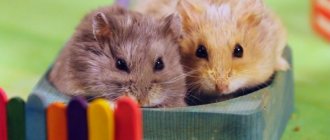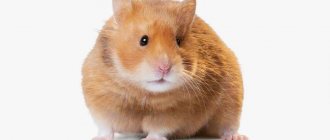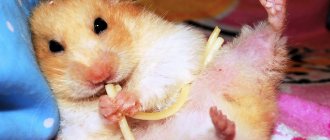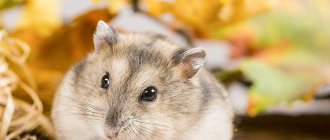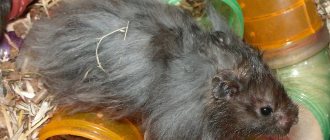- home
- Kinds
01.11.2018 Pets add variety to life and bring joy to children. The dwarf hamster does not take up much space in the house and is undemanding in care. It is enough to get to know the character of the rodent better, understand the principles of caring for it, and an entertaining miniature hamster will bring only pleasant emotions.
Varieties of dwarf hamsters
Proper handling and maintenance of dwarf hamsters requires knowledge of the characteristics and habits of each representative of this species.
The length of these animals does not exceed 50–70 mm, the average weight is 45 grams, and their life expectancy is about two years. Gentle pets need a caring attitude, but they are absolutely not problematic in terms of care and maintenance.
The most common representative is the Djungarian hamster, most often gray-brown in color, with a black stripe on the back. Taylor's dwarf hamsters are very similar to mice. The Campbell's hamster has a beautiful brown coat and a cheerful disposition. The Roborovsky hamster has a magnificent color, the fur on its back and head has a stunning sandy-golden hue, and its belly is white.
Each representative of dwarf hamsters has its own characteristics, but they are united by hyperactivity. This is a distinctive feature from its larger counterparts.
How to care for a hamster
Grooming
Decorative hamsters are quite clean and can take care of their skin on their own. For this reason, veterinarians do not advise washing pets unless absolutely necessary. Such a need can only arise if the hamster is very dirty. If you decide to wash a rodent, remember that you cannot wet its head, only wash its body.
Care for claws and teeth
Since hamsters' teeth and claws grow continuously throughout their lives, their length must be monitored. To do this, conduct an inspection once a week. Teeth and claws should be symmetrical, but not too long.
If a hamster's teeth grow to large sizes, the animal will not be able to eat properly and will die of starvation. To prevent this from happening, place tree branches and mineral stones in the cage, on which the hamster can grind his teeth.
If you notice that your pet is not eating and is drooling, there may still be a dental problem and you should take him to the vet.
Once a week you need to completely change the litter
Djungarian hamster
Djungarians are funny rodents no more than 100 mm long and weighing up to 50 g. The animal has nice thick short fur. In nature, dzhungarikas have a gray-brown back with a bright black “ribbon” in the middle. The belly is always lighter, and the paws are white on the inside. Expressive eyes are black, convex and shiny, the muzzle is white.
Over the course of many years of selection of dwarfs with unusual deviations in color, the nurseries bred animals of interesting colors:
- tangerine almost red, but with the same stripe along the back;
- gray-blue, or sapphire;
- pearl without a characteristic stripe.
Dzungarik with a natural color is more resistant to disease. An animal with a mutation, an unusual color, very gentle and requires special care.
Red, or as they are also called, tangerine hamsters should not have joint offspring in order to avoid the birth of non-viable cubs.
How many children does a hamster give birth to?
The reproductive abilities of these rodents have long been the subject of jokes. Their fertility is really high, especially at home, when hamsters do not hibernate and receive an abundance of food. The ability to reproduce rapidly is a quality that makes rodents so popular as laboratory animals.
Hamsters can give birth to a different number of babies depending on the species and conditions of detention. It is quite precisely known how many hamsters are born to Djungarians - from 4 to 6 pieces. Rarely – 8-9 cubs. Due to their size, dwarf hamsters are not as fertile. But having learned how many hamsters a Syrian hamster can give birth to, an amateur breeder sometimes grabs his head. The average number is 6-10 babies, but sometimes there are 16-18, occasionally even 20 pieces.
The number of babies a hamster can give birth to - both the Djungarian and the Syrian - does not correspond to the number that the female is able to feed. Some of the numerous offspring die or are devoured by the mother. Therefore, the number of surviving hamster babies does not exceed 10-12.
Taylor's Hamster
Taylor's dwarf hamster does not grow more than 80 mm. Because of its nice elongated muzzle and elongated body, it resembles a funny mouse. Beady eyes and tiny ears complete the fabulous picture.
The fur is fluffy and soft, the color is brownish-brown, the belly is white, and there is an elegant dark stripe on top.
Hamster lovers immediately buy a pair, and the animals get along well and breed. After 20 days of pregnancy, the female gives birth to three or even five cubs. She can have 10 offspring in a year.
In addition to its body structure, Taylor's hamster has another similarity with mice: the female and male tenderly care for their offspring.
Rules for handling dwarf hamsters
It was already mentioned a little higher that dwarf hamsters are shy and nervous creatures. Following simple rules will help you avoid stressful situations.
What's not allowed?
- make sudden movements near the cage or scream loudly;
- take a sleepy or just awakened animal;
- cover the pet with your palms on top;
- leaving kids at heights unattended - nimble by nature, they will definitely fall and break;
- take by the skin of the back.
Campbell's hamster
The Campbell's hamster was once classified as a subspecies of the Dzungarik, but at the beginning of the 20th century it received its separate name from the British consul Charles Campbell, who brought amazing animals from the Russian-Chinese border.
Animals of both species are very similar to each other, but there are also significant differences:
- Campbells have slightly tousled fur, compared to the smooth, combed Djungarians;
- Campbells do not change color in winter, unlike dwarfs;
- the body has a “waist”, jungariki are egg-shaped.
Campbell's hamsters can be colored in the following colors: agouti, albino, opal, argenta, black, fawn, dove, blue, chocolate, lilac, blue spotted beige, platinum.
The main sign that this is a Campbell: unlike the friendly Djungarian, he does not like to sit on his hands and tries in every possible way to demonstrate his own independence. This is probably why Consul Charles Taylor liked the animal.
Additional questions and answers
There are some important questions to consider before purchasing a rodent. This will help you choose the right animal and provide it with good conditions.
What is the smallest breed of hamster
Roborovsky hamsters are the smallest breed suitable for home keeping. Among wild rodents, “Taylors” stand out for their compact size.
What is the largest breed of hamster
Among domestic breeds, Syrians are considered the largest. Karbysh is the largest wild rodent.
Who is better to get - a Djungarian or a Syrian hamster?
Both breeds have their advantages and disadvantages. Thus, “Syrians” are larger, have an easy-going disposition and quickly learn to respond to a nickname. However, they need a spacious cage. Djungarian hamsters do not require much space. Now many varieties of this breed have been bred, so it is easier to choose an animal with the desired decorative qualities. Syrian hamsters are easier to care for.
Roborovsky's hamster
Roborovsky's hamsters are named after the Russian scientist who discovered and first described them. The homeland of the animal is China and Mongolia. But they are also found in Russia, for example, in the foothills of the Tien Shan.
Gradually, this animal won the hearts of lovers of miniature hamsters.
It is distinguished by its characteristic “bleached” eyebrows and fur-lined paw soles. Their eyes are always black. The color is most often a chic platinum color. There are variegated, snow-white, agouti, and cinnamon colors. In the wild, Roborov hamsters turn white in winter.
Breeders are attracted by the animal's high immunity to diseases. This is a distinctive feature of the Roborovsky hamster from its brothers.
Black and white hamster - what breed?
Hamsters can be of different colors and patterns. In order to achieve the ideal white or black color, breeders must breed the same 2 ideal black or white hamsters. Usually this color can be found in Djungarian and Syrian hamsters. Under natural conditions, such rodents can be found in the steppes of Siberia, Kazakhstan and the mountains of Dagestan.
Also, albino white hamsters are not a separate breed. They can be of almost any breed.
Care and choice of housing
The animals are extremely active, they need a large cage. You need to pay attention to the distance between the rods, which should not be more than 0.7 cm, otherwise the animal will run away.
Additionally, a running wheel, a small house for sleeping, labyrinths, and a sand bath are purchased.
Large sawdust or shavings are needed as filler, without dust, otherwise it will clog the animal’s airways. Do not use newspapers, as printing ink is poisonous to the hamster.
Hamsters are very clean. There is no need to bathe them, they will take care of themselves. But you need to clean the toilet as often as possible, otherwise an unpleasant odor will appear, and this is stressful for the pet.
It is very useful to let your hamster walk in a special walking ball. 15–20 minutes a day is enough to make a restless animal feel happy.
Today you can see two-level cages for hamsters on sale. Rodents, curious and nimble by nature, will definitely climb to the second floor. And then - depending on your luck. If they fall, there will be a tragedy. This must be taken into account when choosing a home for a miniature, delicate animal.
What to feed
Dwarfs have a high metabolism (metabolism), so they need more calories per gram of weight than their full-sized counterparts.
It is believed that the daily food intake is a tablespoon of grain feed. In any case, it is better to focus on the spot: each organism is an individual, the main thing is not to overfeed and avoid obesity. They feed twice a day.
Insects and twisted boiled meat (beef or chicken) are served as delicacies. The presence of animal protein in the diet of animals during pregnancy and feeding of offspring is especially important.
Don’t forget about liquid, which is necessary for any organism: the drinking bowl should always be filled with clean water at room temperature.
Hamsters' teeth are constantly growing, so it is vital for rodents to sharpen them. To prevent the baby from gnawing everything, a chalk stone, twigs, or even dog treats are placed in the cage. Neither has a negative effect on the dental or digestive system.
Composition and nutritional standards
The dwarf hamster is an omnivore. But there is no need to abuse this quality to the detriment of the rodent and feed it everything that a person has on the table.
The basis of the menu for hamsters is seeds, cereals, greens, fruits and vegetables. Hamsters develop activity and appetite, so it is better at this time.
In the morning, it is enough to give him pieces of fruit, vegetables, corn, peas, and a dandelion leaf. In the evening, the diet can be supplemented with fish, chicken breast, cooked without salt and spices.
Your hamster should always have water. Remove spoiled food promptly, otherwise the animal will be poisoned. The animal should always have grains in its bowl, otherwise it will think that the cold weather is coming and it’s time to stock up for the winter.
You cannot offer your hamster citrus fruits, pomegranate, kiwi, cookies and candies, chocolate, watermelons, cabbage, milk, sausage, chips, hot crackers and other foods that will quickly damage the rodent’s gastrointestinal tract.
Possible diseases
Dwarf hamsters may have the following diseases:
- conjunctivitis, when the eyes fester, the eyelids stick together;
- diarrhea due to poor diet;
- damage to the cheek pouches from spicy food;
- bite wounds;
- worms;
- improperly growing teeth due to the fact that hamsters are not provided with crackers and twigs for grinding them down;
- cystitis from infection or drafts;
- scabies, which is usually caused by the scabies mite.
For any diseases, you should not treat your hamster with “folk remedies”, but immediately show it to a veterinarian.
When caring for dwarf hamsters, you need to follow this principle: the less stress he has, the longer he will live. You need to train yourself not to raise your voice in the presence of a hamster, not to make sudden movements. Ultimately, you will prolong the life of not only your pet, but also yourself.
Source
Features of reproduction
In order for the couple to be successful and fertile, hamsters are accustomed to each other from an early age. If you plan to breed hamsters, it is advisable to immediately take a pair. There is no need to experiment with different subspecies. Only cubs born from Dzungariks and Campbells are viable.
In captivity, rodents can bear offspring all year round. As soon as the female turns four months old, she is ready to bear offspring. An earlier pregnancy is undesirable; it can have a bad effect on the mother’s well-being. The female carries the cubs for 20 days. One litter can have up to 12 newborns.
The female needs to create favorable conditions. First of all, this is a diet rich in protein foods; in addition, buy a complex of vitamins. Before giving birth, you need to remove the male. Remove labyrinths and simulators, add more sawdust. The female will make a good nest for herself.
Bald, blind and deaf hamsters will acquire a “beautiful” appearance in just a week. After 15 days they will be feeding themselves. After 25–30 days, the cubs need to be “sorted” by gender and placed in cages.
You cannot pick up babies. The female may become angry, react aggressively to someone else's scent and show a tendency towards cannibalism. If the hamster falls out, it is picked up with a spoon, which is first dipped in the bedding.
Cleaning the cage
To delay the “general” cleaning of the cage, the following actions must be carried out every day:
- remove leftover food;
- Remove feces and any part of the litter soiled by them;
- Remove wet litter.
Once a week, you can completely change the bedding by rinsing the cage tray a little. More thorough cleaning should be done every 2-3 weeks.
IMPORTANT! When cleaning the cage, do not use chemicals. Even a small dose of chemicals can harm your pet's health.
It’s better to buy a pair of different-sex hamsters at once
Description of the rodent
Red hamster eats a leaf
– Advertisement –
Hamsters are small rodents with a dense build, short legs, small ears and short tails. The body length ranges from 5 to 34 cm, the tail is from 0.7 to 10 cm in length. Females can exceed males in size. The fur is thick, the back is colored from ash or brownish-gray to dark brown-ochre. The abdomen is found in black, white or gray. There is a pronounced black stripe on the back. Hamsters also differ from other types of rodents in having well-developed cheek pouches.

